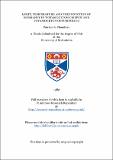Light, temperature and the induction of dormancy in 'Potamogeton crispus' and 'Potamogeton obtusifolius'
Abstract
Dormancy in many aquatic angiosperms is characterized by the production of turions, specialized vegetative buds which function as both propagules and perennating organs. In temperate climate species, induction of dormancy is usually associated with short days, often in conjunction with low temperatures. By contrast, the turions of Potamogeton crispus are formed around midsummer and the species grows luxuriantly throughout the winter. The environmental factors controlling turion formation in Potamogeton crispus were investigated under natural and laboratory conditions. Potamogeton obtusifolius, a typical temperate climate species exhibiting autumnal turion production, was studied for comparative purposes. Phenological development of natural populations in two Scottish lakes was compared with seasonal measurements of temperature, daylength, underwater light attenuation and light quality (the red and far red wavelength bands). Temperature and photoperiod were identified as the primary environmental factors regulating turion formation in both species. Laboratory experiments confirmed the field observation that turions are produced by Potamogeton crispus in response to long days (greater than 12 to 16h) and high temperatures (greater than 16°C). In Potamogeton obtusifolius, turion production is associated with short days and high temperatures. Because of the complexity of the underwater light climate, the effect of light quantity (irradiance) and light quality on turion production could not be determined. Laboratory experiments showed that under inductive photoperiodic and temperature conditions, low red:far red ratios and low irradiance inhibited turion formation in Potamogeton crispus. The action of phytochrome in the perception of the long day photoperiodic signal and the quantitative effect of sucrose concentration on the magnitude of turion production in Potamogeton crispus was investigated. A model of phytochrome action in the control of photoperiodic and photomorphogenetic responses in aquatic angiosperms is presented and the role of turions in the life history of Potamogeton crispus and Potamogeton obtusifolius is assessed.
Type
Thesis, PhD Doctor of Philosophy
Collections
Items in the St Andrews Research Repository are protected by copyright, with all rights reserved, unless otherwise indicated.

